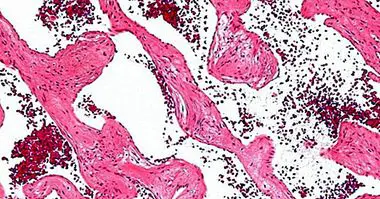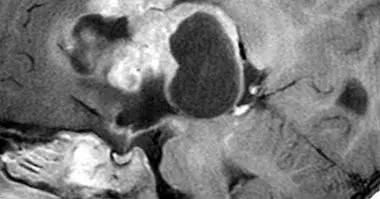Differences between DNA and RNA
All organisms have nucleic acids . They may not be so well known by this name, but if I say "DNA" the thing may change.
The genetic code is considered a universal language because it is used by all types of cells to store information about its functions and structures, which is why even viruses use it to survive.
In the article I will focus on clarify the differences between DNA and RNA to understand them better.
- Related article: "Genetics and behavior: do genes decide how we act?"
What are DNA and RNA?
There are two types of nucleic acids: deoxyribonucleic acid, abbreviated as DNA or DNA in its English nomenclature, and ribonucleic acid (RNA or RNA). These elements are used to make copies of cells, which will build the tissues and organs of living beings in some cases, and unicellular life forms in others.
DNA and RNA are two very different polymers, both in structure and functions; However, at the same time they are related and essential for the correct functioning of cells and bacteria . After all, even if your "raw material" is different, its function is similar.
- Maybe you're interested: "What is epigenetics? Keys to understanding it "
The nucleotides
The nucleic acids are formed by chains of chemical units called "nucleotides". To put it in some way, they are like the bricks that make up the genotype of different life forms. I will not go into much detail about the chemical composition of these molecules, although there are several differences between DNA and RNA.
The centerpiece of this structure is a pentose (a 5-carbon molecule), which in the case of RNA is a ribose, whereas in DNA it is a deoxyribose. Both give name to the respective nucleic acids. Deoxyribose gives more chemical stability than ribose , which makes the structure of DNA more secure.
Nucleotides are the cornerstone for nucleic acids, but they also have an important role as a free molecule in the energy transfer in metabolic processes of cells (for example in ATP).
- Related article: "Types of major cells of the human body"
Structures and types
There are several types of nucleotides and not all of them are found in both nucleic acids: adenosine, guanine, cytosine, thymine and uracil . The first three are shared in the two nucleic acids. Thymine is only in DNA, while uracil is its counterpart in RNA.
The configuration taken by the nucleic acids is different according to the way of life that is being talked about. In the case of eukaryotic animal cells like human Differences between DNA and RNA are observed in its structure, in addition to the presence of the aforementioned different thymine and uracil nucleotides.
The differences between RNA and DNA
Below you can see the basic differences between these two types of nucleic acid.
1. DNA
The deoxyribonucleic acid is structured by two chains, which is why we say that it is double-stranded. These chains draw the famous double helix linear, because they are intertwined between them as if they were a braid.
The union of the two chains occurs through links between the opposite nucleotides. This is not done randomly, but each nucleotide has affinity for one type and not another: adenosine always binds to a thymine, while guanine binds to the cytosine.
In human cells there is another type of DNA besides nuclear: mitochondrial DNA, genetic material which is located inside the mitochondria, organelle responsible for cellular respiration.
Mitochondrial DNA is double-stranded but its shape is circular instead of linear. This type of structure is what is typically observed in bacteria (prokaryotic cells), so it is thought that the origin of this organelle could be a bacterium that joined the eukaryotic cells.
2. RNA
Ribonucleic acid in human cells is linear but it is single-stranded, that is, it is configured by forming only one string. Also, by comparing their size, they are shorter than the DNA strands.
However, there is a wide variety of RNA types, three of which are the most outstanding, since they share the important function of protein synthesis:
- Messenger RNA (mRNA) : acts as an intermediary between DNA and protein synthesis.
- Transfer RNA (tRNA) : transports amino acids (units that form proteins) in protein synthesis.There are as many types of tRNAs as amino acids used in proteins, specifically 20.
- Ribosomal RNA (rRNA) : they are part, together with proteins, of the structural complex called ribosome, which is responsible for carrying out protein synthesis.
Duplication, transcription and translation
Those that give name to this section are three very different processes and linked to nucleic acids, but simple to understand.
Duplication only involves DNA. It occurs during cell division, when the genetic content is replicated. As its name suggests, it is a duplication of the genetic material to form two cells with the same content. It is as if nature made copies of the material that will later be used as a plane that indicates how an element has to be built.
Transcription, on the other hand, affects both nucleic acids. In general, DNA needs a mediator in order to "extract" information from genes and synthesize proteins; for this he makes use of RNA. Transcription is the process of passing the genetic code from DNA to RNA, with the structural changes involved.
The translation, finally, only acts on the RNA. The gene already contains instructions on how to structure a particular protein and has been transcribed into RNA; now only missing move from nucleic acid to protein .
The genetic code contains different combinations of nucleotides that have a meaning for the synthesis of proteins. For example, the combination of the nucleotides adenine, uracil and guanine in RNA always indicates that the amino acid methionine will be placed. Translation is the passage from nucleotides to amino acids, that is, what is translated is the genetic code .
- Related article: "Are we slaves of our genes?"



















